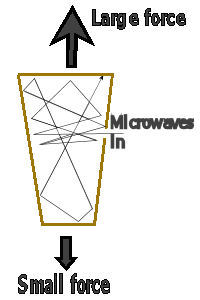 The drive works by bouncing microwaves inside a specially shaped container with one end wider than the other. At the narrow end the microwaves are reflected more and transfer less momentum to the end wall than at the wide end. Since they are moving at about the speed of light they move, according to Einstein's special theory of relativity, in their own frame of reference and independently of the container.
The drive works by bouncing microwaves inside a specially shaped container with one end wider than the other. At the narrow end the microwaves are reflected more and transfer less momentum to the end wall than at the wide end. Since they are moving at about the speed of light they move, according to Einstein's special theory of relativity, in their own frame of reference and independently of the container.The actual article has been copied many times on Internet and has even it's own section now on Wikipedia (where the controversy about the drive is discussed more than the drive itself.)
Many debunk the drive as being the same as 'Roadrunner on a skateboard with a sail propelled by a fan on the skateboard'. Yet it should be testable even at home using some parts from an old microwave, a copper foil container and a sensitive electronic balance. (It might be advisable to do it from a distance if you don't want to cook yourself).
What's more of interest to me are the potential implications of a working device.
Assuming a superconducting container, preferably one working at room temperature, then Shawyer calculates a thrust of 30,000 Newtons per kilowatt of power input may be possible. That's enough for us to do away with the internal combustion engine and also to lift a vehicle off the ground. New Scientist shows a diagram of a wingless plane lifted by relativity drives and moved forward by a hydrogen fueled gas turbine. What, however, is to stop the turbine being replaced by yet another relativity drive and the power being obtained from a fuel cell?
Without the need for wings there would be no ceiling for such a vehicle. Space would be as accessible to the individual as the roads are today. The drives themselves should not cost a fortune - after all there are no moving parts unlike an internal combustion engine. Granted you will need to spend money on creating a sealed environment for the driver and passengers and on collision avoidance systems and navigation since there are no roadsigns in space.
Want to visit Auntie on the other side of the world? Just hop in your relativity drive vehicle climb out of the atmosphere, accelerate (maybe powered by solar energy) and coast like a satellite around the world. It may take you a couple of hours but you won't have to wait for the airline to check you in, seat you, and so on. With the availability of cheap personal transport international borders will become a nonsense so you can forget about passports, visas, immigration control, airport security and all that rubbish. Instead of going for a night out in the local town a UK resident could pop over to Vegas for a few hours.
Terrorism? No airplanes and no reason for it anyway since the world's population would be free to move, live and work wherever they want. That includes the rest of the solar system too! Now that might unsettle governments but ... who cares about govenment. I for one would like to see a little democratic anarchy.
Live near an airport? Your house value is going to rise without those noisy planes. A relativity drive vehicle (shall we say RDV from now on?) will be silent. After a while though house prices in the city will fall as cheap personal transport makes living in the country more feasable.
Privacy in your garden? Hmm - that may be a problem with silent RDVs floating overhead. But then anyone who has seen Google Earth or local.live.com will know that back garden privacy will soon be a thing of the past.
Work for a rail service/shipping firm/airport/road construction? Better start looking for a new job. Motor industry? You are going to be selling and maintaining RDVs instead.
Work in the oil industry? Well there won't be the demand for petrol (gas), diesel or aviation fuel but oil products will still be needed for heating and as raw materials. It might reduce pollution and global warming.
How about space travel? By that I mean travel between the Earth and the Moon and planets. We'll have to overcome the absence of the Van Allen belts protecting us against radiation but the good news is that the Sun is expected to go through a quiet phase for a while making interplanetary travel much simpler. If you want a good field to invest in for the future try space suit manufacture and autopilots.
I'm sure there are lots of other ways the RDV would change our lives and I invite you to add them to this blog.
4 comments:
You can see my opinions on Shawyer's 'drive' at http://www.assassinationscience.com/johncostella/shawyerfraud.pdf.
Regards
John Costella
Well it seems that the relativity drive isn't quite dead yet, it's now been adopted by the Chinese according to this article Chinese Say They're Building 'Impossible' Space Drive
It's been claimed that NASA has investigated the relativity drive. As yet though, there isn't any evidence of a working drive being constructed.
Here's another link to an article on the subject http://www.theverge.com/2015/5/11/8586857/nasa-impossible-engine-em-drive
Post a Comment